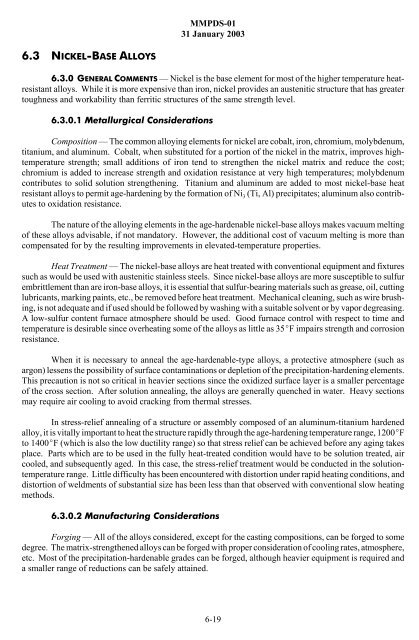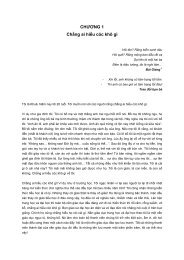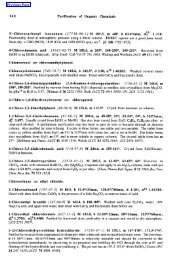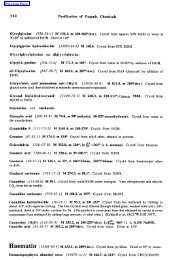Inconel 600.pdf
Inconel 600.pdf
Inconel 600.pdf
Create successful ePaper yourself
Turn your PDF publications into a flip-book with our unique Google optimized e-Paper software.
MMPDS-01<br />
31 January 2003<br />
6.3 NICKEL-BASE ALLOYS<br />
6.3.0 GENERAL COMMENTS — Nickel is the base element for most of the higher temperature heatresistant<br />
alloys. While it is more expensive than iron, nickel provides an austenitic structure that has greater<br />
toughness and workability than ferritic structures of the same strength level.<br />
6.3.0.1 Metallurgical Considerations<br />
Composition — The common alloying elements for nickel are cobalt, iron, chromium, molybdenum,<br />
titanium, and aluminum. Cobalt, when substituted for a portion of the nickel in the matrix, improves hightemperature<br />
strength; small additions of iron tend to strengthen the nickel matrix and reduce the cost;<br />
chromium is added to increase strength and oxidation resistance at very high temperatures; molybdenum<br />
contributes to solid solution strengthening. Titanium and aluminum are added to most nickel-base heat<br />
resistant alloys to permit age-hardening by the formation of Ni 3 (Ti, Al) precipitates; aluminum also contributes<br />
to oxidation resistance.<br />
The nature of the alloying elements in the age-hardenable nickel-base alloys makes vacuum melting<br />
of these alloys advisable, if not mandatory. However, the additional cost of vacuum melting is more than<br />
compensated for by the resulting improvements in elevated-temperature properties.<br />
Heat Treatment — The nickel-base alloys are heat treated with conventional equipment and fixtures<br />
such as would be used with austenitic stainless steels. Since nickel-base alloys are more susceptible to sulfur<br />
embrittlement than are iron-base alloys, it is essential that sulfur-bearing materials such as grease, oil, cutting<br />
lubricants, marking paints, etc., be removed before heat treatment. Mechanical cleaning, such as wire brushing,<br />
is not adequate and if used should be followed by washing with a suitable solvent or by vapor degreasing.<br />
A low-sulfur content furnace atmosphere should be used. Good furnace control with respect to time and<br />
temperature is desirable since overheating some of the alloys as little as 35EF impairs strength and corrosion<br />
resistance.<br />
When it is necessary to anneal the age-hardenable-type alloys, a protective atmosphere (such as<br />
argon) lessens the possibility of surface contaminations or depletion of the precipitation-hardening elements.<br />
This precaution is not so critical in heavier sections since the oxidized surface layer is a smaller percentage<br />
of the cross section. After solution annealing, the alloys are generally quenched in water. Heavy sections<br />
may require air cooling to avoid cracking from thermal stresses.<br />
In stress-relief annealing of a structure or assembly composed of an aluminum-titanium hardened<br />
alloy, it is vitally important to heat the structure rapidly through the age-hardening temperature range, 1200EF<br />
to 1400EF (which is also the low ductility range) so that stress relief can be achieved before any aging takes<br />
place. Parts which are to be used in the fully heat-treated condition would have to be solution treated, air<br />
cooled, and subsequently aged. In this case, the stress-relief treatment would be conducted in the solutiontemperature<br />
range. Little difficulty has been encountered with distortion under rapid heating conditions, and<br />
distortion of weldments of substantial size has been less than that observed with conventional slow heating<br />
methods.<br />
6.3.0.2 Manufacturing Considerations<br />
Forging — All of the alloys considered, except for the casting compositions, can be forged to some<br />
degree. The matrix-strengthened alloys can be forged with proper consideration of cooling rates, atmosphere,<br />
etc. Most of the precipitation-hardenable grades can be forged, although heavier equipment is required and<br />
a smaller range of reductions can be safely attained.<br />
6-19











